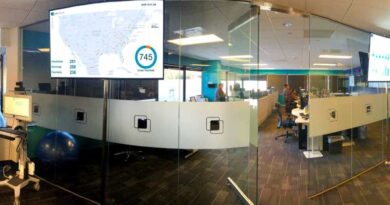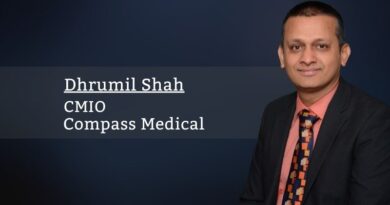Remote monitoring helps COVID patients at home, where they heal best
By Lance M. Owens, CMIO, Metro Health
This happened almost overnight: The federal Centers for Disease Control reported a 154% increase in telehealth visits during the last week of March 2020, compared to the same period in 2019. With hospitals overwhelmed and patients in lockdown, the pandemic flipped the switch to activate a movement that had been building for years.
As innovative tools and technology continue to enhance the virtual experience, healthcare systems face new questions. How can we leverage these advances and growing acceptance by patients? How can we take virtual care to the next level, particularly as the pandemic continues?
Designing the program was a multidisciplinary effort that focused on the dual objectives of Metro Health’s digital health strategy.”COVID-19 has accelerated widespread transformations in healthcare delivery and technology, perhaps nowhere more dramatically than telehealth adoption.
Although the recent expansion of telehealth has emphasized primary-care visits, we also have the opportunity to address the challenges of the pandemic itself by mitigating its burden on our health systems and at the same time, improving patient outcomes.
Home-based monitoring of select COVID-19 patients, paired with telehealth, offers just such an opportunity.
Serving patients where they want to be
On Nov. 30, in the wake of the pandemic’s second U.S. wave, Metro Health – University of Michigan Health launched a 24/7 home-monitoring program for ambulatory COVID-19 patients at our 208-bed hospital in Wyoming, Mich.
By discharging certain patients to recover at home, where they are most comfortable and heal best, we have been able to keep more beds available and limit exposure and workload for staff. In the first month of operation, 33 patients enrolled, saving more than 300 hospital stays.
When an attending physician clears an ambulatory COVID-19 patient for home recovery, we equip the patient with an internet-connected tablet and Bluetooth-synched peripherals: thermometer, blood pressure cuff, pulse oximeter, and scale. We teach them how to use the equipment and we send them home.
Patients take multiple readings a day and answer surveys about their wellbeing, including questions that screen for the depression commonly seen with COVID-19 cases. The readings and responses are automatically entered for remote monitoring by a team of medical professionals. Patients have video visits with providers – which family members can join virtually – and can ask for help via the portal.
Metro Health designed and launched the program in 10 days and we have heard nothing but rave reviews from patients.
No patient wants to be confined to a single room without visitors for any amount of time, let alone the notoriously long length of stay for COVID-19 hospitalization. Studies show patients heal better where they are most comfortable, sleeping in their own bed, eating their own food, and surrounded by the comforts of home.
Technology that enhances the patient-provider experience
Designing the program was a multidisciplinary effort that focused on the dual objectives of Metro Health’s digital health strategy.
“We always want to preserve the intimacy between patient and provider – to enhance, not get in the way of that experience,” said J. Josh Wilda, Chief Information Officer. “We also seek technology that extends when and where we can treat our patients.”
Remote patient monitoring is increasingly recognized for its potential to reduce hospital readmissions, improve outcomes and support data-based care decisions. Metro Health had been exploring expanding its home-monitoring program for cardiology patients, but the pandemic inspired a pivot.
“We are excited for how this and other digital health tools will allow us to shift the patient care model in the appropriate settings, putting more tools in the hands of the patients to be more involved in their care with their providers,” Wilda said.
Metro Health worked with Health Recovery Solutions to design and launch the program. The system integrates with our electronic health record system, Epic, and has the ability to add approved family members to the patient portal for virtual visits.
A robust clinical role
Deploying technology is only part of the equation. At Metro Health, we knew a successful launch would require collaboration across the board, from IT, case management, hospital staff, and importantly, our medical group.
Since we do not have an established monitoring center, we leveraged employed staff across our system to check the patient portal around the clock. This involves physician assistants, nurse practitioners, nurses, medical assistants, and case managers supported by physicians and specialists.
Nurses and medical assistants check the portal at least every two hours during the day and every four hours at night. Providers monitor the portal throughout the day as they conduct virtual visits with patients. Appointments are scheduled for days one, two, four, seven, and 10.
The system also issues alerts if a patient’s readings or responses fall outside established parameters. For example, if a patient’s pulse ox reading is out of range, email and text notifications go out to multiple staff members. Nurses triage the patient, determining whether to escalate the case and bring in the nurse practitioner, physician assistant, or physician.
In addition to being popular with patients, the system has been embraced by Metro Health providers. Gerrit J. Kleyn, a primary care PA at one of our outpatient clinics and part of the team that supported this innovation, put it this way:
“Being able to assist patients while they convalesce from COVID in their own homes has been one of the most rewarding things I have been involved with. We receive daily words of appreciation from our patients and their families for the level of care we were able to provide through the virtual equipment.”
Looking beyond COVID-19
One of the hallmarks of the pandemic era has been the ability of medical organizations to adapt and develop solutions for challenging situations.
Like all good innovations, remote monitoring has potential beyond the pandemic, with opportunities to prevent hospitalizations and support post-hospital recovery. Metro Health is exploring expanding home monitoring for patients with congestive heart failure and COPD to reduce the risk and cost of readmission common with these conditions.
The goal is to provide the expert caring relationship that patients deserve in a setting that makes them happiest – at home.



